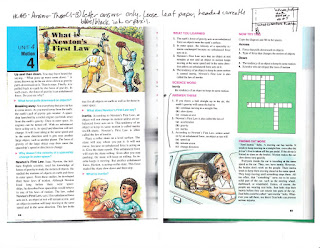Friday, 30 January, 2009
Students should be able to:
-describe how balanced forces affect motion.
-explain how net force, mass, and acceleration are related.
-identify action and reaction forces.
The do now was from the Mastering the FCAT book, page 26 question 31:
An automobile approaching a traffic signal comes to a complete stop. What is the direction of the force acting on the automobile with respect to the motion of the automobile? Explain your answer.
Since this is a short response question, be sure to use part of the question in your answer. Use complete sentences and answer only what is asked. Your answer should be three to four sentences long.
Students then took 3 column notes on Newton's laws. They made a table in their notes with the column headings:
Newton's Laws of Motion
Law----State the Law-----------Example or Illustration of the Law
1
2
3
Students read aloud from the text from pages 110-115 and completed the chart using the information from the text. Those students at home can use the Reading Essentials book, pages 53-57 to find the information needed to complete the table.
There is no home learning assignment.










